 The ambiguous history of potatoes in Russia has been around for almost 300 years, and almost two-thirds of these people enjoy well-deserved love among the people. Unpretentious in cultivation and adapted for survival in various climatic zones, potatoes acquired the title of "second bread".
The ambiguous history of potatoes in Russia has been around for almost 300 years, and almost two-thirds of these people enjoy well-deserved love among the people. Unpretentious in cultivation and adapted for survival in various climatic zones, potatoes acquired the title of "second bread".
And even an inexperienced farmer who planted this root crop on his plot and has some idea of the mechanism of watering and hilling, is able to get a good crop by the end of the season, if not for one “but”. The Colorado potato beetle, this insatiable conqueror that penetrated the west of the Soviet Union in the 1940s, by 2000 began to be firmly associated with potatoes in the minds of residents of all regions of our country.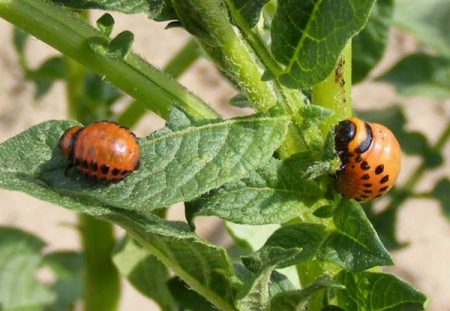
Content
- 1 The value of the Colorado potato beetle for potato farms
- 2 The value of flowering potatoes for the ripening of tubers
- 3 Is it possible to spray potatoes from the Colorado potato beetle during flowering
- 4 Safe Potato Processing Techniques for Colorado Potato Beetle During Flowering
- 5 Rules for spraying potatoes during flowering
The value of the Colorado potato beetle for potato farms
Many summer residents who are not able to permanently live in their suburban areas throughout the summer season, at least once in their garden practice, have encountered the following situation. The planted potato tubers went well, the first hilling took place, the wet summer does not require frequent watering, and some circumstance (for example, a long-awaited vacation) did not allow the landowner to visit his site for one to two weeks. And upon arrival at the cottage, the owner sees a dead potato plot consisting of bare stalks completely eaten by bugs. The yield from the field is minimal and does not even compensate for losses on the purchased planting material. This picture is especially characteristic for the southern regions of the country, where humidity is lowered and average summer temperatures are high. In the warm, arid climate of Central Asia, the Colorado potato beetle gives 4 generations per year, and in extremely hot weather there are massive years of adult insects at a distance of several kilometers downwind at a speed of 8 km / h. Not finding potato plantations along the way, the beetle eats wild nightshade, including poisonous black nightshade and bleached, until it reaches a new cultivated field. It is not surprising that, to our time, this malicious pest has conquered the whole world, except England, where strict quarantine is organized against it, and Antarctica.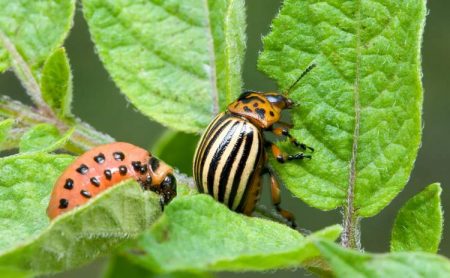
The Colorado potato beetle, as a rule, does not feed on the potato tubers themselves, either in the adult or in the larval stage. One can meet insects on root crops only at the beginning of spring, when overwintered hungry adults find smelling tubers ready for planting and restore strength before the first shoots appear. Although this species of insect formed in the deserts of the Sonora province in Mexico, where beetles fed on wild plants of the nightshade family, today the main and favorite food of the Colorado leaf beetle is green potato tops. Although, on the forums of vegetable growers, user statements are quite common that, when there are nearby plantings of potatoes, eggplant and pepper, the beetle prefers more tender shoots of the last two crops, and only after the destruction of the pulp of the pepper leaves it switches to eating potato tops. In all likelihood, this state of affairs is facilitated by the spread of modern potato varieties with stiff, pubescent or bitter foliage due to glucosides, which are more resistant to pest eating.This, for example, “Nikulinsky”, “Bryansk reliable”, “Kamensky”, “Shurminsky-2”, “Sulev”, “Temp”, “Olev”, “Kiev svitanok”, “Thought”, “Lasunok”, “Morning” early "and others.
The larvae of the Colorado potato beetle are the most dangerous for potato plantations, and although each immature individual eats no more than 30 milligrams of leaf pulp per day, the mass of pests and the ability of adults to give several generations per season can lead to the destruction of 40 percent of the tuber harvest. The mass of clutches and, as a consequence, the larvae, the voracity of young and adult individuals, adaptability to frost and drought, insensitivity to many poisons, and quick addiction to insecticides brought the Colorado potato beetle to the top of the list of potato enemies.
Therefore, to ignore this pest in its potato farm, unfortunately, will not work.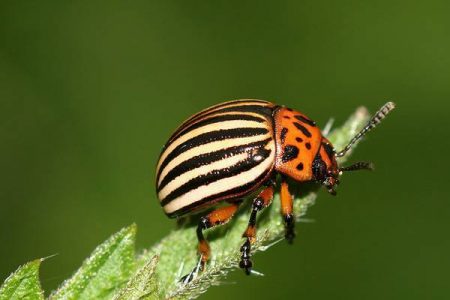
Scientists are closely studying the life cycle of the striped leaf beetle, chemists and genetics synthesize new insecticides, and farmers and gardeners are trying out old folk remedies to plague them. Although a universal and absolutely safe panacea for the Colorado potato beetle has not yet been found, many vegetable growers have quite effective methods of dealing with it, and gardening stores offer an assortment of strong and relatively harmless chemicals. Today, for many, it remains relevant not to find means of counteracting this gluttonous pest, but the question - Is it possible to process potatoes from beetles during flowering? Let's try to figure it out.
The value of flowering potatoes for the ripening of tubers
Despite the fact that only tubers have the main nutritional and industrial value in potatoes, for the high-quality formation of these formations, the plant needs to carry out a full vegetative development cycle. In the green aboveground part of the bush in the sunlight, photosynthesis occurs - a key process of plant metabolism, in which monosaccharides (glucose molecules) are synthesized from simple inorganic compounds, and then complex polysaccharides, including the desired starch. Starch polymers accumulate in the storage organs of potatoes - root tubers. The quantity and size of tubers depends on the quality and duration of photosynthesis, the sufficiency of the starting materials and the presence of common favorable factors (heat, lighting, humidity, soil air and underground space). This makes it clear why, when the green mass is damaged by a Colorado potato beetle, the root crop suffers. Having grown green mass and developing generative organs, the potato bush begins to deposit nutrients “in reserve”. The emergence and formation of tubers in the mid-early varieties of potatoes popular in Russia occurs during flowering, the dates of which coincide with the period of the highest activity of adult insects and their larvae. Eating beetroot beetle at this important time for plants inhibits the formation of tubers, since the synthesized nutrients do not go to underground "storages", but in an attempt to repair damaged organs. In addition, during injury to the stem, spores of fungi and viruses can enter the wounds, which will lead to damage to the crop and infection of the site. The importance of flowering for a potato crop is indirectly confirmed by the fact that the practice of removing inflorescences, which is used by some gardeners, can lead to an increase in the number of tubers by 1 - 2 pieces, but the root crops themselves grow small, uneven, and contain little starch.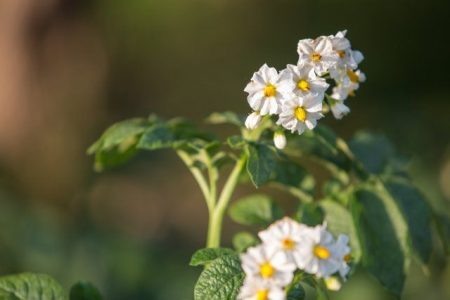
An exception is some modern varieties of potatoes, in which the absence of flowering or a small number of flowers in the brush is the norm. These are the ultra-early Rocco, Timo, Empress, and Mariella. Variety "Spring" forms buds only in wet summers and fades very quickly, and during periods of drought does not bloom at all.The exclusion of flowering in this case is beneficial for the farmer, since the plant does not spend energy on the formation of organs that do not have economic value.
Is it possible to spray potatoes from the Colorado potato beetle during flowering
Many gardeners and a large percentage of entrepreneurs who grow potatoes for sale, carry out insecticidal processing of potatoes at any time during the growing season. The effect of staining beetles with potent chemicals of new generations is always expressed in the preservation of the aboveground parts of the bushes and, as a consequence, in an increase in yield. However, it is well known that chemical synthetics are especially strongly accumulated in tubers precisely during the flowering period of potatoes. By the way, a lot of debate is about the advisability of using industrial poisons in other periods of the plant’s life cycle, because these substances tend to accumulate in the soil, interact harmfully with beneficial soil microflora and fauna, and are absorbed by subsequent generations of plantings. On the scale, which in this debate expresses a negative attitude to the processing of potatoes during flowering, one can also put such a thing as lightning-fast adaptation of the beetle to all new chemical preparations. It’s enough to recall the sensational DDT insecticide (trademark “Dust”), which was sensational in the USSR in the 1950s, which at first successfully fought with the Colorado potato beetle and other agricultural pests, and then ceased to act on them. to poisons is a genetically-based mechanism for removing plant alkaloids from the body. The food base of the Colorado potato beetle in its historical Mexican habitat was toxic nightshade, deadly poisonous to most other herbivorous insects. The exchange system of the beetle is adapted not only to recognize and remove dangerous substances, but also knows how to accumulate compounds harmful to the body in tissues. This metabolic mechanism makes the host inedible for most predators, as evidenced by the bright warning coloration of adults, larvae, and masonry. The only exception among the toxic substances is modern systemic toxic chemicals (for example, Confidor Maxi Extra). These insecticides penetrate the plant through the roots and accumulate in all its organs. Insects get poison, eating poisoned parts of the plant, and die. Unfortunately, many systemic insecticides linger in the soil for up to 10 weeks, can harm a person by contact and eating processed plants, and also destroy insect helpers, fish and pets. The toxicity of chemicals for bees, carnivorous insects, and beneficial amphibians is another important reason, because of which it is highly not recommended to process potatoes from beetles during flowering with pesticides.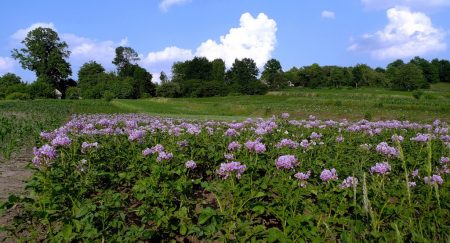
The development of environmental science, microbiology, and nanotechnology, which has sharply accelerated in recent years, has led to the emergence of an unprecedented direction in the chemical industry — the production of biological insecticides. The active agents in these preparations are microorganisms - natural pests of the Colorado potato beetle (some strains of fungi and bacteria) - and entomopathogenic nematodes.
Fungal insecticides (avermectins) secrete neurotoxins, which lead to paralysis and death of the insect. In addition, conidia of some microscopic fungi can penetrate the body of an insect and infect its organs, causing death. Avermectins are sensitive to humidity, temperature and light conditions, they need to be stored in the cold without access to light and should be used after fine spraying in the evening.
Bacterial pathogens are isolated from strains of soil microorganisms and act through the intestinal tract of insect pests by producing toxins.These drugs are produced in the form of a dry powder, stored for up to one and a half years under normal conditions, and, unlike fungal insecticides, almost do not cause allergies in humans.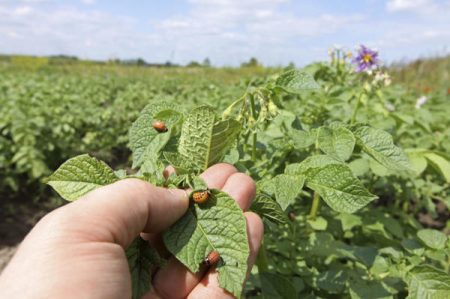
Insecticides based on EPN - entomopathogenic nematodes are the most promising and effective drugs of the 4th generation. Microscopic worms enter the body of adult insects and larvae with food and infect hosts with symbiotic bacteria that produce the toxin. Nematodes are sensitive to dryness, EPN treatment should be carried out after finely aerosol sprinkling in the evening.
Numerous studies show that insecticides based on natural microcultures are not phytotoxic, almost do not harm humans, bees, fish and warm-blooded animals, quickly inactivate in the environment, do not accumulate in the soil and tissues of organisms, and often have a narrow effect, and most importantly, are not addictive in a target pest. Despite the higher cost, these drugs are being actively studied and may in the future displace synthetic analogues. However, the effect on the health of humans and beneficial animals, as well as the entire spectrum of ecological relationships of these microorganisms, is far from completely studied, therefore it is advisable to observe preventive precautions when working with them.
Safe Potato Processing Techniques for Colorado Potato Beetle During Flowering
As we have already found out, spraying potatoes from the Colorado potato beetle during flowering with chemically active preparations is unsafe for human health and farm animals and has detrimental effects on the biocenosis as a whole. Now consider the more harmless methods of combating the Colorado potato beetle, which can be used during this growing season of the plant.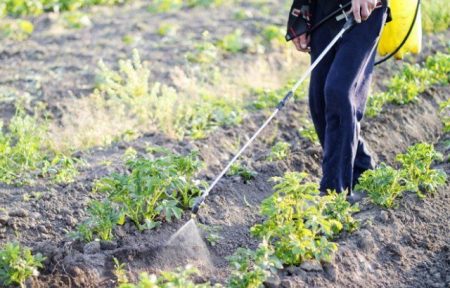
- First of all, the bioinsecticides mentioned in the previous chapter will help get rid of pests. The fungal preparations AvertinN and Aversectin C, acting on the larvae of the Colorado potato beetle, bacterial Bitoxibacillin, Fitoverm, and nematode Nemabakt show good results on potatoes. Agravertin, Akarin and Bikol are also popular among farmers. In garden centers you can find the Colorado potato beetle!, Aktofit, Boverin and Aktarofit bioinsecticides brands. Remember that all biological insecticides and their toxins decay very quickly in the environment and have a delayed effect. If the previous generation of Colorado potato beetle larvae is not completely destroyed and mature individuals remain on the culture, it will be necessary to carry out new spraying of potatoes during flowering and at its end. Before using any drug, it is necessary to carefully read the instructions and strictly follow the recommendations for use. The number of repeated treatments and the final effect strongly depend on climatic conditions, the general condition of the plants, the timing of use, and can radically differ among different users.
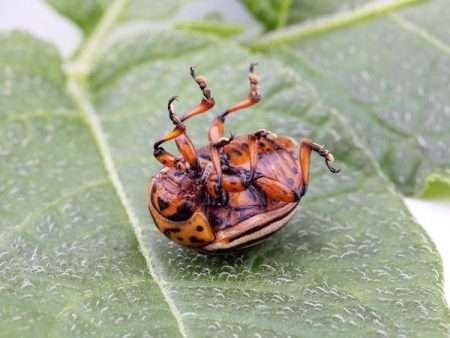
- Mechanical collection of insects is advisable on small plantations. At the same time, one should not forget about the specific protective behavior of the imago, when in danger it does not fly away, but falls to the ground, pretending to be dead. If a hidden bug is not noticed, after a few minutes it will again be on the plant. Summer residents advise the following method. Pest collection should be carried out together. The man walking first shakes off adults with a long broom with a long handle in a wide net, previously set under the bush. The next "hunter" robbing larvae and masonry by hand. The mechanical collection of beetles is quite tedious, but after several “sorties” to the site the whole family can save the potatoes of the current year from damage, and the farmers from the crop failures.
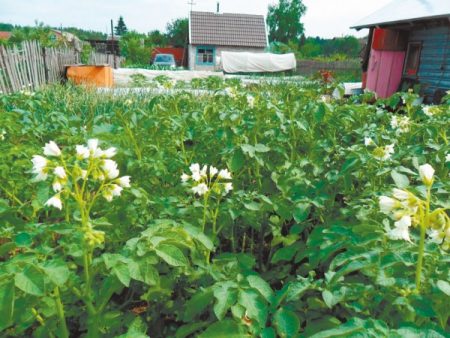
- How to spray potatoes during flowering, folk wisdom will tell. Powder dusting with wood, especially birch, ash, or irrigation with an ash-soap solution will not only poison the beetle, but also saturate the plants with natural potassium, which will increase productivity. Potatoes should be showered on morning or evening dew or after rain with an interval of 2 weeks. Dilution of ash in soapy water (30 g of ash and 3-5 g of laundry soap per 1 liter of water) will make the solution more adhesive and allow the product to stay better on the leaves, including on the underside, where the masonry is located and parasitizes the first generation of larvae. forget to sprinkle the ground under the plants. The ash consumption is large - about 10 kg per hundred square meters. You can spray potatoes from the Colorado potato beetle during flowering with a solution of tar (100-150 g of birch tar in 10 l of water). Tar is a concentrated product of processing birch ash and even surpasses the feedstock in terms of efficiency.
- You can poison the beetles when the potato blossoms with the infusion of onion husks. Approximately 0.5 kg of husk, pour boiling water in a bucket and leave for 2 days, then add soap to the undiluted infusion and sprinkle the potatoes on all sides. The adult beetle does not like the smell of rotting onions, and its number on the site will decrease.
- With caution, you should irrigate plantings with infusions and decoctions of fragrant plants - basil, calendula, currants. An infusion of garlic helps. Why it is impossible to poison the Colorado potato beetle during flowering of potatoes with self-made preparations from poisonous plants is understandable. Alkaloids obtained from assistants customary at other times, such as hemlock, gooseberry, wormwood, tansy, celandine, etc., will get into the forming tubers and reduce their taste or make them unfit for food. Try to take 100 g of dry hot pepper and boil it for 2 hours in 10 liters of water, and add 50 g of soap to the cooled broth.
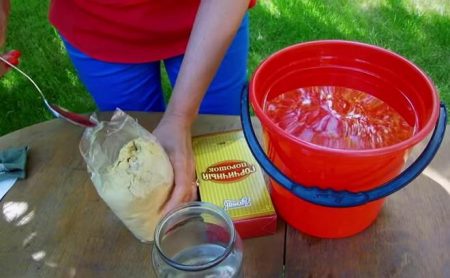
- Beetles on potatoes during flowering are successfully etched with nicotine infusion (0.5 kg of tobacco per 10 liters of water should be set for 24 hours and before use add laundry soap).
- Powdered corn flour is also considered a good way to combat potato leaf beetle. Corn dust eaten by a larva or imago swells and damages internal organs from moisture in the intestinal tract of the insect.
- Grazing certain types of poultry on potato plantations unexpectedly leads to good results. If chickens of the Faverol breed from 20 days old mix grated potato tubers and a little chopped tops with green food, and at the age of 1 month add 0.5 adult beetles, gradually increasing the dose, then hungry young animals can be released at 3 months old plot of land with potatoes. Unfed guinea fowl eat pests even without accustoming. Turkeys also cope well with a beetle, but unlike chickens and guinea fowls, these large birds are able to break the plants themselves. To use poultry as fighters with leaf beetle, you will have to completely abandon the additional processing of potatoes. The only acceptable remedy is dusting with cornmeal. In addition, guinea fowl and turkeys are better to trim feathers, because these birds have not completely lost their ability to fly, and it is reasonable to fence the potato field.
- Colorado beetles eagerly eat starlings, shrews and moles. These animals should not be scared away from the garden.
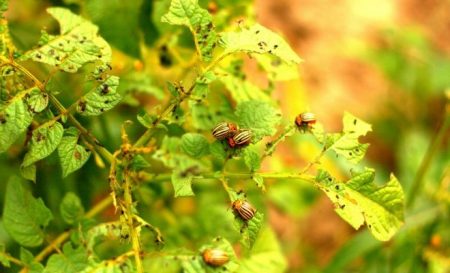
Rules for spraying potatoes during flowering
How to process potatoes from the Colorado potato beetle during flowering is up to you. But we strongly recommend that you adhere to more natural for the plant, ecology and human spontaneous control of leaf beetle. We summarize the recommendations on the technique for carrying out treatments with plant and biological insecticides.
- Many active substances contained in herbal decoctions and infusions are inactivated by exposure to sunlight.Therefore, ready-made solutions should be applied immediately, choosing evening hours closer to sunset. At the same time, the danger of plants getting a sunburn due to the lens-forming properties of moisture drops is eliminated.
- Use laundry soap as an adhesive.
- Alternate means to avoid insects getting used to one type of active substance.
- If possible, use personal protective equipment, wash hands and face after treatments, do not allow children and pets to plantation.
- Clearly follow the instructions and dosage on biological products
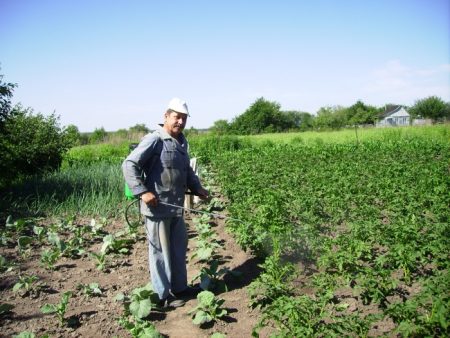 .
.
If the processing of potatoes from the Colorado potato beetle during flowering with chemical preparations still does not raise your concerns, we recommend that you familiarize yourself with the rules for its implementation:
- Use factory sprayers.
- Do not neglect protective clothing, gloves and a respirator.
- Remove strangers, especially children, and pets from the field.
- It is extremely dangerous for health during the procedure to smoke, drink and eat food.
- Do not store working solutions for more than a day.
- It is better to process plants in the early morning, evening at sunset or in cloudy but not rainy weather to avoid sunburn on the leaves.
- Wind and rain that has passed earlier than a day after the end of pollination will reduce the effectiveness of the work.
- Tubers harvested 40 to 60 days after the last treatment (depending on the preparation) are suitable for food.
The forums of potato growers demonstrate how topical the question for compatriots is, is it possible to poison the Colorado potato beetle when the potato blooms. The temptation to quickly and certainly solve the problem with the help of potent pesticides meets strong resistance to sanity not only among the owners of small summer cottages, but also with larger landowners.
“This beast easily gets used to poisons, produces an antidote and inherits the ability to produce it. And she loves nitrogen fertilizers, which do not feed our gardeners with bread, but let them cram into the ground. Grow vegetables on organics - and your potato will grow such a tough tops that no bug can handle it ... yes, chicken droppings are also a thing, but after harvesting. ”
"No you can not. I have the same situation in the country - one part of the potatoes is blooming, and some are not yet. I grass selectively, but not blooming. Although it is not very convenient and time consuming.
It is believed that at this time tubers are formed, therefore, potatoes should not be sprayed. ”
“For the time of flowering, I prefer to collect them every day, and you can spray them before flowering. But after that I don’t do anything, since the tubers are already formed and the beetle isn’t scary. ”




 Description and description of varieties in Belarus with a photo
Description and description of varieties in Belarus with a photo Do I need to pick flowers from potatoes: why do they do it
Do I need to pick flowers from potatoes: why do they do it When to dig potatoes: timing and availability of new potatoes
When to dig potatoes: timing and availability of new potatoes How to grow a good potato crop: various methods and methods, planting and care
How to grow a good potato crop: various methods and methods, planting and care